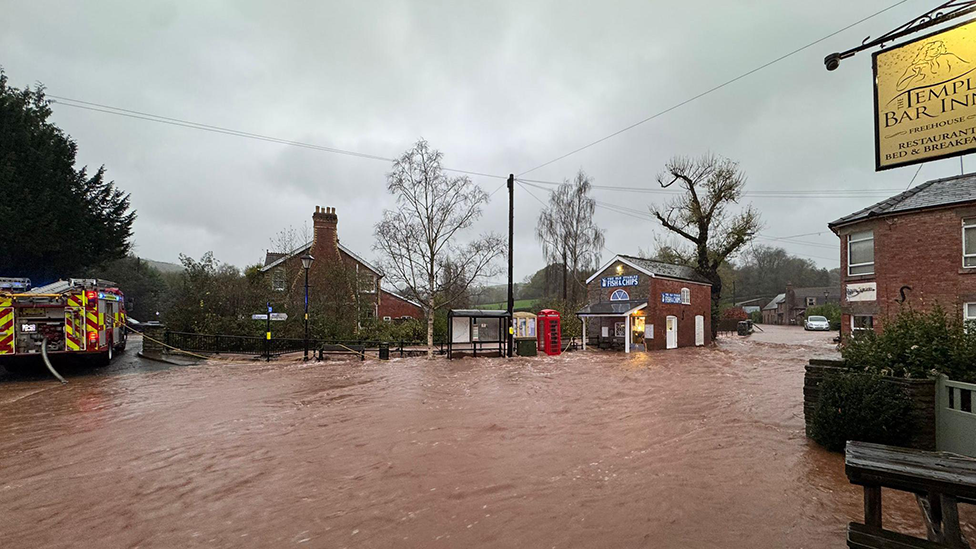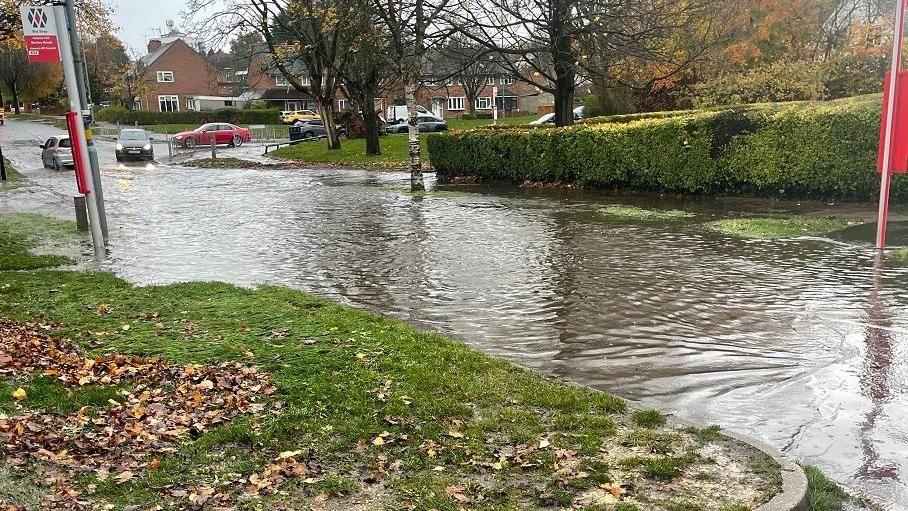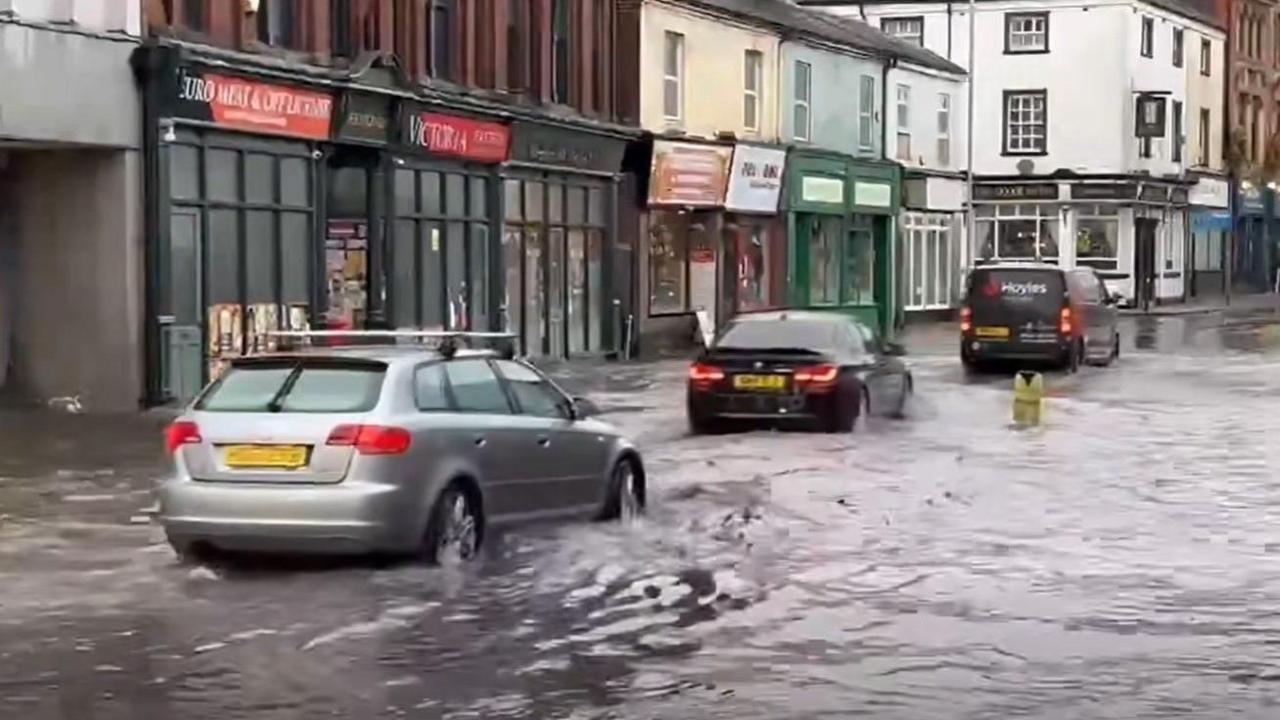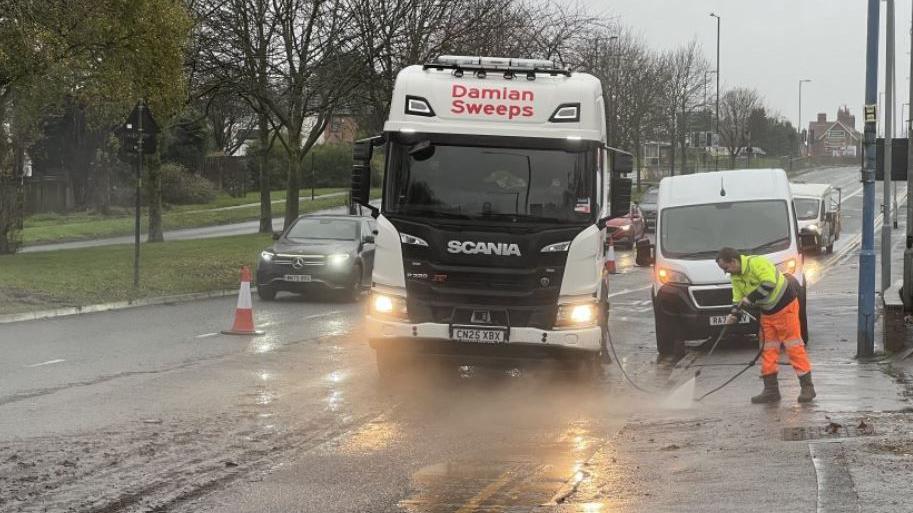Is there anything we can do to ease flash floods?

Several roads across the region were under water after heavy rain on 12 November
- Published
Storms have caused flash floods across the West Midlands in recent weeks, but is there anything we can do about it?
Climate change means heavy rain and flooding are likely to become more frequent, while experts have highlighted the impact more housebuilding is having on drains and other infrastructure.
However, they suggest there is more we can do to keep our streets and homes flood-free.
Stoke-on-Trent saw flash floods in October followed by Birmingham and Coventry in November, even before Storm Claudia particularly affected Herefordshire and Shropshire.
Flood awareness campaigner Mary Long-Dhonnau said most drains were Victorian, too small to cope with climate change and "woefully inadequate", but she emphasised it still helped to keep them clear.
Ms Long-Dhonnau, better known as Flood Mary, said a report following summer 2007 floods, external found that drains had been overwhelmed, but she said there was also a consensus in some areas that even if they had flowed correctly, people would still have been flooded because of the sheer volume of water.
As more developments were built, drains became "more and more stretched", she added.
"We've paved and concreted our entire world, so when that water hits the ground running, it goes into people's homes and it can't soak away into soft ground," Ms Long-Dhonnau said.

Mary Long-Dhonnau said we have all got to think about working with nature
Birmingham University hydrology expert Prof David Hannah said weather extremes in the UK were "putting a significant strain on management of water in urban spaces".
He called for both engineering and nature-based solutions to be embedded into planning policies, as part of climate-change adaptation.
Prof Hannah said nature-based measures included rain gardens - sunken spaces to store and slow some of the heaviest rain - and green roofs, along with more permeable surfaces.
"The results will be better flood risk management, enhanced biodiversity, and better health and access to green space for residents," he said.
'Better prepared'
Last week, Princes Drive in Leamington Spa remained flooded for four days after Storm Claudia.
Matt Western, MP for Warwick and Leamington, wrote to the council about drains maintenance, external, adding: "Given it rains a lot in this country, we should be better prepared."
In response, the council said it acknowledged how "frustrating the recent closure of Princes Drive was for everyone trying to travel through the area".
It said highways and flood risk management teams were looking at the site to see what could be done to offset future incidents, but added that its gully maintenance work had been on track and that it had increased resources during the storm.

Ewyas Harold in Herefordshire bore the brunt of flash floods last week
When Storm Claudia arrived, many councils were quick to say they had extra highways teams out making sure that drains were cleared of leaves and other blockages.
Shropshire Councillor Dan Thomas, who represents Much Wenlock, thanked highways teams for their "relentless" work clearing drains, adding that he was "100% convinced it made the difference between the town flooding and not".
However on social media, some residents across the West Midlands highlighted blocked drains they felt were making floods worse.
One woman in Coventry described "people slipping due to wet leaves on footpaths and cyclists falling", and another said pavements were "flowing like a river".
Mark O'Connell, responsible for highways at Coventry City Council, said all drains were inspected during the year with 85% cleaned.
He said claims the authority did not tackle leaf fall were "completely wrong".

Rain-fed ponds are designed to be dry until heavy rainfall, in turn reducing water flowing into drains
Ms Long-Dhonnau said we all had "to think about working with nature".
She said steps people could take included installing water butts, which would prevent water flowing off roofs from going into drains, and help to stop them being overwhelmed.
Different surfaces could be used for driveways, she added. One example was a plastic, honeycombed surface that let grass grow through, and water pass, but kept the ground hard enough to park a car.
Planters could be used if people did not have room for a garden, she added, and drainpipes could empty into planters.
People worried about drainage could also install non-return valves, or toilet and shower bungs which were more affordable, she said.
Ms Long-Dhonnau said she knew of a row of terraced houses that had flooded in Hull - all apart from one property.
That one property had a water butt and no hard paving, she said, adding: "He didn't flood. Everybody else did."
She has published free advice on how to prepare for floods, external.

Flash floods hit a road in Bartley Green on 12 November
Like other councils, Mr O'Connell said flood risk was considered as part of the planning process, and developers had to consider or mitigate against rain run-off and flood water.
The Local Government Association (LGA) said councils were "on the front line" during severe weather and called for them to receive more support, particularly with many facing financial pressures.
'Not fit for purpose'
Councillor Arooj Shah, chair of the LGA Neighbourhoods Committee, said there needed to be more frequent engagement between the Environment Agency, water companies and councils, and as well as "greater flexibility and transparency" from government on funding support schemes.
"Funding mechanisms designed for once in every 10 years flooding events are not fit for purpose," she said.
"And the financial pressures on local government have an impact on their ability to address issues such as flooding as much as they'd like."
The government-commissioned report published a year after the 2007 summer floods made it clear that severe weather was only likely to become more common.
"The probability of this type of intense rainfall occurring in the future is likely to increase due to climate change," it stated.
The question is to what extent our infrastructure and planning has changed over the past 17 years.

Streets in Stoke-on-Trent were flooded last month
A spokesman for Defra told the BBC: "By investing at least a record £10.5bn until 2036, we will break the cycle of communities struggling to recover from flooding.
"This government inherited flood defences in the worst condition on record, but through increased maintenance and repair, the nation is better prepared than we were this time last year."
He said funding rules had been simplified, making it "quicker and easier to deliver the right flood defences in the right places".
"Alongside this, 20% of future investment will also be set aside to help the most deprived communities in England," he added.
The department said councils were required to manage local flood risks from surface water, groundwater and watercourses.
Defra said the majority of council funding was "un-ringfenced", recognising local authorities were best placed to decide how to meet pressures.
National planning policy makes clear developments should use sustainable drainage when there could be drainage impacts, but Defra is continuing to explore whether more needs to be done.
- Published14 November

- Published12 November

- Published30 November 2024
